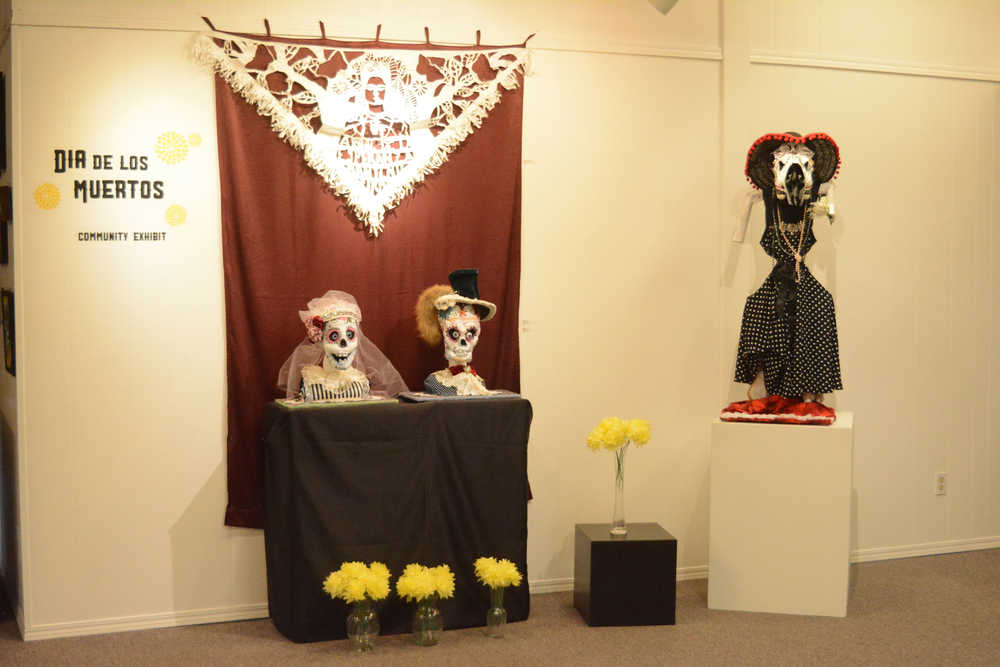At the quarter point between the equinox and the solstice, spiritual and secular celebrations appear in numerous cultures, such as the Celtic tradition of Samhain, the Christian tradition of Allhallowtide and the secular holiday of Halloween.
Christians honor the dead, saints and martyrs, and Pagans mark the end of the harvest and the transition into winter, when spirits and fairies more easily come into our world.
Mexicans in the United States and Mexico honor the dead with a similar festival, Dia de los Muertos, the Day of the Dead, traditionally held on Nov. 2.
“The theory is that is when the veil between life and death is flimsy. You can actually talk to and feel the spirits of the life that’s departed,” said Peggy Paver, executive director of the Homer Council on the Arts.
This month, HCOA features a community art show, “Dia de Los Muertos,” that invited Alaska artists to consider the cultural tradition. The show features two- and three-dimensional art of many media, including prints, sculpture, fabric art, ceramic art, found art and photography.
At 6 p.m. Oct. 29, there is a festival of the art that includes fire spinning and dancing. The show will remain up through Halloween,
Dia de Los Muertos has its roots in the Aztec culture, and originally was held in the summer. Gradually it came to coincide with Allhallowtide. Born and raised in Tucson, Ariz., in the Southwest, Paver came to Dia de Los Muertos through Tucson’s All Souls Procession, a parade of costumes that culminates in an aerial fire show. When she became director of HCOA and started working on planning for the next year’s gallery shows, an October slot came open. Why not have a Dia de Los Muertos community art show? Paver thought. Before leaving Tucson, Paver lost both parents.
“It’s just something that’s kind of special to me,” she said of Dia de Los Muertos. “It’s a special way to remember people who have been important in molding us.”
HCOA has done several community art show over the years, and Paver said she was pleased at the reception for Dia de Los Muertos.
“I really enjoy that process,” she said of community art shows. “People here are so creative.”
Dia de Los Muertos art has various themes, such as vividly decorated skulls. In celebrations, people wear masks or paint their faces in skull designs, an idea Carol Comfort, Devry Gerity and Kelsey Waldorf did when Waldorf made up her face and photographed it. Comfort and Gerity decorated the photo with origami marigolds — the traditional Dia de Los Muertos flower.
The celebration also features altars honoring the dead ones, usually dioramas of skeletal dead surrounded by objects of their lives.
Lynn Marie Naden has a found object diorama and Betsy Rogers’ painted 3D printed sculptures in a diorama. Another altar also features a bride-and-groom set of skulls by Colleen Gifford with a cut-Tyvek fabric work by Desiree Hagen.
Two large sculptures by Robert Walsh and Kelli Parker dominate the show. Other works are more subtle, like Jeff Szarzi’s ceramic platter with murre bird designs.
That work seems out of place with the Dia de Los Muertos motifs, but people who remember the thousands of murre carcasses that washed up on Kachemak Bay beaches will see the connection.
“The platter was inspired by my love for birds and how to memorialize what happened to the common murres recently,” Szarzi writes of his work. “I think it is important to pay attention to what is happening in our environment and to remember what happened in the past.”
Paver said stories like that came with the works. When people came to drop off work, the artists all wanted to talk about their creations.
“The thing that was different for me for this exhibit was people were so enthusiastic,” Paver said. “The pieces just showed up. The way people handled them when they brought them in — they told us this show was special.”
Paver said she hoped Dia de Los Muertos will become an annual exhibit — and perhaps evolve into a larger celebration. She also said she hoped the show would make people less death phobic and think more about loved ones they have lost.
“People lose people all the time. Death is a part of life. It’s important for people to process their experience in creative ways.”
Michael Armstrong can be reached at michael.armstrong@homernews.com.



